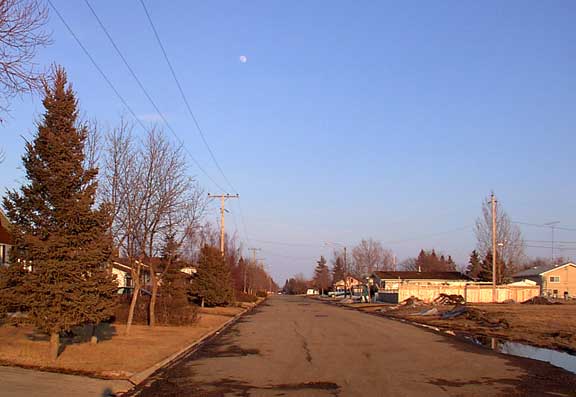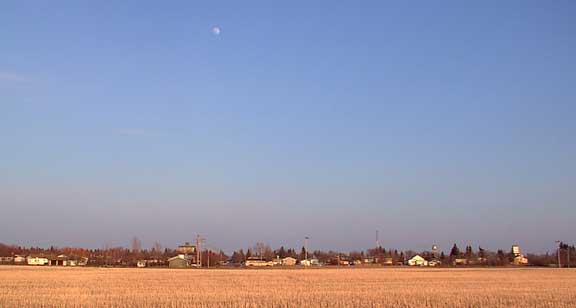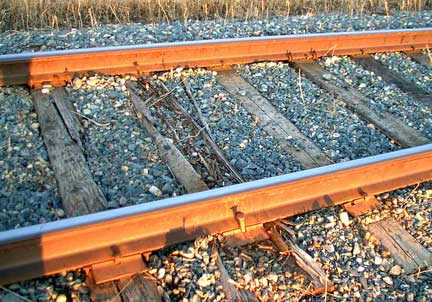|
A Walk West |
 |
| FTLComm - Tisdale - April 6, 2001 |
| Though it was still only about four degrees above freezing it was a fine evening
and a good change to get outside. There is a simplicity in going for a walk, you
get to make choices, choices that will determine what you will see and what you will
think about but we rarely ponder these choices and in this case for me it is automatic.
East is fine, North is okay and South is interesting but when the sun it setting
there is only one direction to go and that is West. With only a block from the edge
of town this decision had the distinct possiblity of producing a short walk. At the end of the Street I looked back into Tisdale and took the picture seen above with the sun behind me and the spring street to the East. I then ambled off across some grass through two ditches and found myself on a stubble field of last year's canola. This time last year or the year before such a field would have been powder dry but this year it was only the mulch from last years harvest that prevented me from descending into a mire. |
 |
| A few hundred yards of squishy stubble field and then I came to the ditch by the CP rail line with still hip deep snow. Careful stepping only saw me sink to mid thigh twice. Once up on the track it was a place just begging to be photographed. The sky, the setting sun the monoscape of flat land all around so below is a QuickTime VR panorama of that scene as you begin looking North and swing all around to see what the town looks like from this view point. (As stated before if this scene appears on your screen vertically you do not have QuickTime loaded in your machine download the free viewer and you will be able to enjoy this scene and QuickTime movies as well. Microsoft's media player is incapable of displaying a virtual reality scene.) |
(The apparent break in the rail looking North and the extra rail looking South are both anomolies from the blending process of combining many pictures together to present this scene as a panorama) |
 Now wanting to temp fate any more I chose not to return over the soft field but would walk home on the railway track. In the one block length of CP track I encountered eight destroyed tyes like this one (on the right) and it is easy to see that the road bed has been moving up and down as you can see countless spikes standing well above the rails they are suppose to be holding down in place. Railway tracks will work up and down as a train passes over them and if the road bed is soft the damage can rapidly increase often this sort of thing leads to derailments. |
 Southern Saskatchewan has had several derailments this winter included two in the Wilcox area due to broken rails. This CP line has heavy steel in it but the rails are in tough shape. In this one block of distance several badly deformed rail ends were seen and these two almost opposite one another were photographed. The end of a rail takes considerable pounding from heavy loads and the ball (top) of the rail will deform spreading out and this of course increases the impact of each passing |
 wheel to the point that the rate of damage increases and ultimately failure will occur. In the picture on the right you will notice that pieces of steel have left the rail and both ends of the joint are hammered out. With conditions like this trains have to reduce speed considerably to prevent knocking out the track from under them. But the real danger for a community is the possiblity of hazardous commodities being carried in a train and the track giving way, spilling dangerous chemicals into the environment. |
 |
 This is a "daimond" a railway crossing railway with the CN line going East and West and the CP line passing North to South. These are expensive structures and have a high potential for causing a derailment. Often when worn these things are changed as a single unit, but from the pieces nearby it is likely that this one has been repaired many times to keep it safe. However as you can see the little arrow points to a clean break in an outer support to this structure. There is a good chance that this break alone is not a serious danger as this piece of equipment has built into it a good deal of strength and redundancy but it does suggest a need to be checked out. |
| Having spent a bit of time working on the railway in another time, I can see that both lines were straight and have great ballast but the CP line looks like it certainly could use some work. The steel on the CN line is lighter but its tyes are excellent and in general it is in much better repair. |
 |